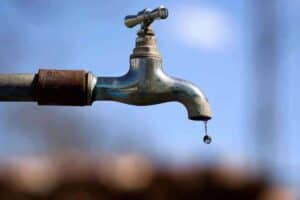Here's what level the Vaal Dam stood at this week, while 22 other dams around the country recorded levels below 40%.

The Department of Water and Sanitation’s (DWS) latest weekly report revealed a significant decline in the country’s dam water levels.
South Africa’s dam levels
Twenty-three dams nationally recorded levels of under 40% of their capacity, with some going as low as below 1%.
KwaZulu-Natal and Gauteng are the only provinces with dams that have proportionately high capacities.
The highest reserves in these provinces stood at 61.5% at Spring Grove Dam and 74% at Bronkhorstspruit Dam.
Free State
The Vaal Dam, an essential part of the Integrated Vaal River System (IVRS), recorded a capacity of 33.1% of its full storage capacity (FSC) of 2.5 billion cubic metres, this week.
The department’s comparison noted that it went down from 34.8% the previous week, and 73.6% last year.
As part of the 14 dams that make up the IVRS, the Vaal will also draw water from Sterkfontein Dam if it reaches a certain low mark.
“The standard operating rule is that Sterkfontein Dam releases water to the Vaal Dam when the Vaal Dam reaches a level below 18%,” DWS Communication Services’ Sanku Tsunke confirmed to The Citizen.
Sterkfontein Dam was listed as being at 97.7% of its 2.6 billion cubic metre FSC, as per the 4 November reading.
ALSO READ: Jo’burg water crisis worsens as authorities scramble for solutions
Eastern Cape
This week, three out of 45 dams in the Eastern Cape recorded capacities below 40%.
Debe Dam, with a 6.4 million cubic metre FSC stood at 26.4%, seeing an increase from last week where it sat at 25.7%. Last year it was slightly higher at 38.6%.
Lubisi Dam saw a decrease to 35.7% from last week’s 36.3%. With an FSC of 113.6 million cubic metres, last year Lubisi had a much higher level of 73.9%.
Nuwejaars Dam increased from 14.2% last week, to 19.3% this week. Last year, it was also below 30%, standing at 20.7%.
ALSO READ: ‘No drought in Gauteng’, but province is experiencing water security challenges
Limpopo
Limpopo’s dam levels are concerning.
Glen Alpine Dam stood at 0.2% this week, with an FSC of 18.9 million cubic metres. Last week the dam was at 0.6%. These levels are a stark difference to last year’s 50.7%.
Middel-Letaba Dam this week stands at 0.7% of its FSC of 172.0 million cubic metres, maintaining the same level as the previous week. Middel-Letaba was at 3.6% last year around the same time.
Modjadji Dam’s latest available data is the same as last week, standing at 29.2%. Last year, around the same time, the dam boasted a much higher level, standing at 60.0% with an FSC of 7.2 million cubic metres.
Nsami Dam with an FSC of 21.9 million cubic metres this week stands at 11.8%. Last week it was at 12.0% and last year, it boasted a capacity of 53.4%.
Nwanedzi Dam, with an FSC of 5.2 million cubic metres, recorded 11.2%, an increase from last week’s 9.9% capacity. Last year, around the same time, Nwanedzi boasted a much higher level of 77.4%.
ALSO READ: R10 billion a year spent, but 3 million homes still without running water
Mpumalanga
Ohrigstad Dam has the lowest level in Mpumalanga, maintaining last week’s level of 16.7%. It has an FSC of 13.5 million cubic metres , and stood at 58.4% last year.
Westoe Dam was the second lowest, meeting only 35.3% of its capacity. This is a slight decrease from last week’s 35.4%.
Last year Westoe was almost half full at 44.0%. It has 60.1 million cubic metres FSC.
ALSO READ: Mpumalanga dam levels continue to drop. Here’s where they stood this week
Northern Cape
Out of six dams in the Northern Cape, only two were below half of their capacity.
Karee Dam, which has a 1 million cubic metres FSC, recorded 35.1% this week, maintaining last week’s level.
Karee was at 91.5% of its capacity last year around the same time.
Leeubos Dam, also with a 1 million cubic metres FSC, was at 0%. It was completely dry last year as well.
North West
Kromellenboog Dam, with an 8.7 million cubic metres FSC, stood at 36% of its capacity. This was a decrease from last week’s 38.3% and a huge drop from last year’s 73.3%.
Lindleyspoort Dam stood at 23.8%, decreasing from 25.1% last week, and 80.8% last year. Lindleyspoort has a 14.3 million cubic metres FSC.
Madikwe Dam recorded a 22.9% capacity, a decrease from 23.2% last week. With a 16 million cubic metres FSC, it had a much higher water level last year, sitting at 64.9%.
Marico-Bosveld Dam was also less than quarter of its full capacity, at 22.6% this week and 24.2% last week, while it boasted 67.8% last year. It has a 27.0 million cubic metres FSC.
Molatedi Dam slightly decreased to 27.6%, from 27.9% last week. It was almost double this level last year, at 53.3%.
Ngotwane Dam, of 19.1 million cubic metres FSC, was at a stable 32.2% since last week. It was only at 37.2% last year.
Pella Dam stood at 19.8% this week, down from 20.5%. Last year it stood at 49.8%. Pella has a 2.2 million cubic metres FSC.
Swartruggens Dam’s level was below 1%, recording 0.7%. It was at the same level last week. This is a significant decrease from its level of 76.5% last year, with a 0.5 million cubic metres FSC.
Vaalkop Dam decreased to 29.5% this week, from 30.3% last week. It boasted 84.3% last year. Vaalkop has a 51.4 million cubic metres FSC.
ALSO READ: Here is how much extra Tshwane would pay under level 2 water restrictions
Western Cape
Leeugamka Dam decreased to 13.7% this week, from 15.5% last week. It was at 36.1% last year. Leeugamka has a 13.5 million cubic metres FSC.






